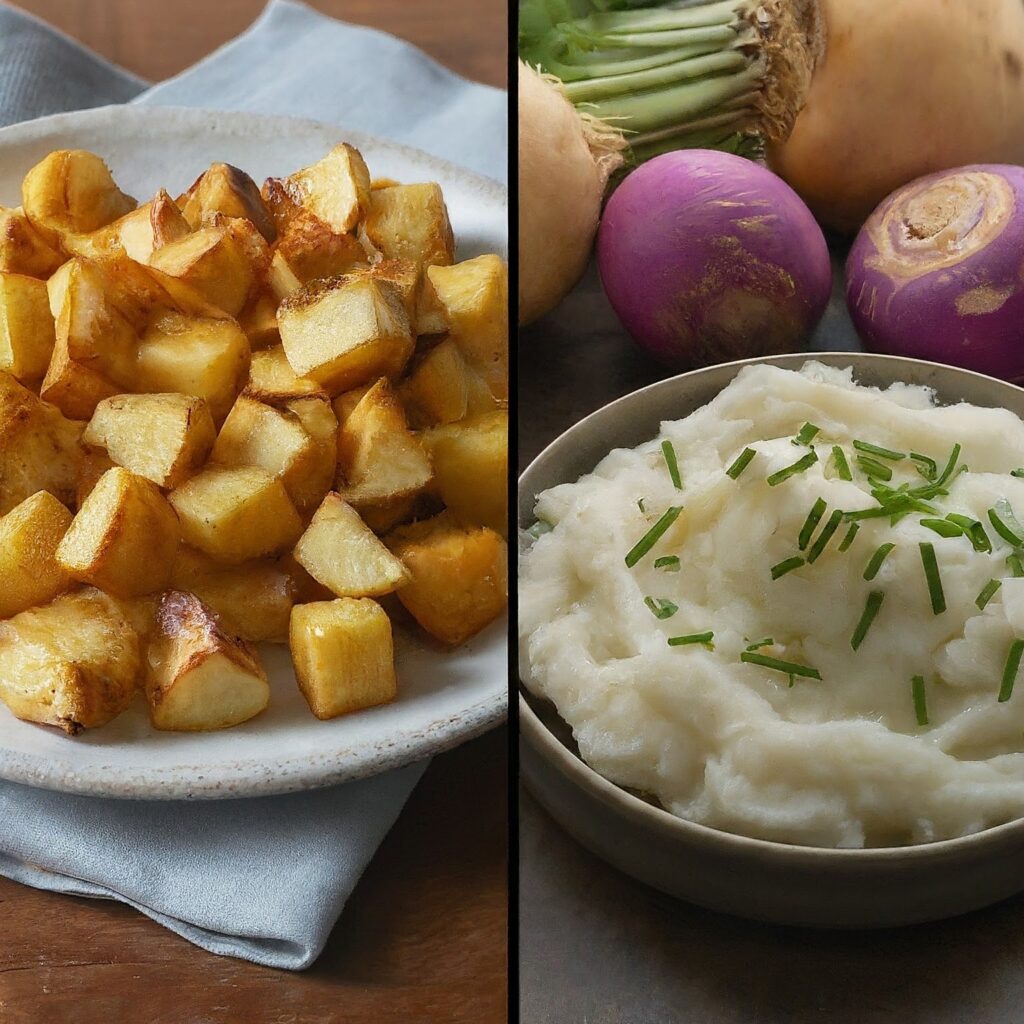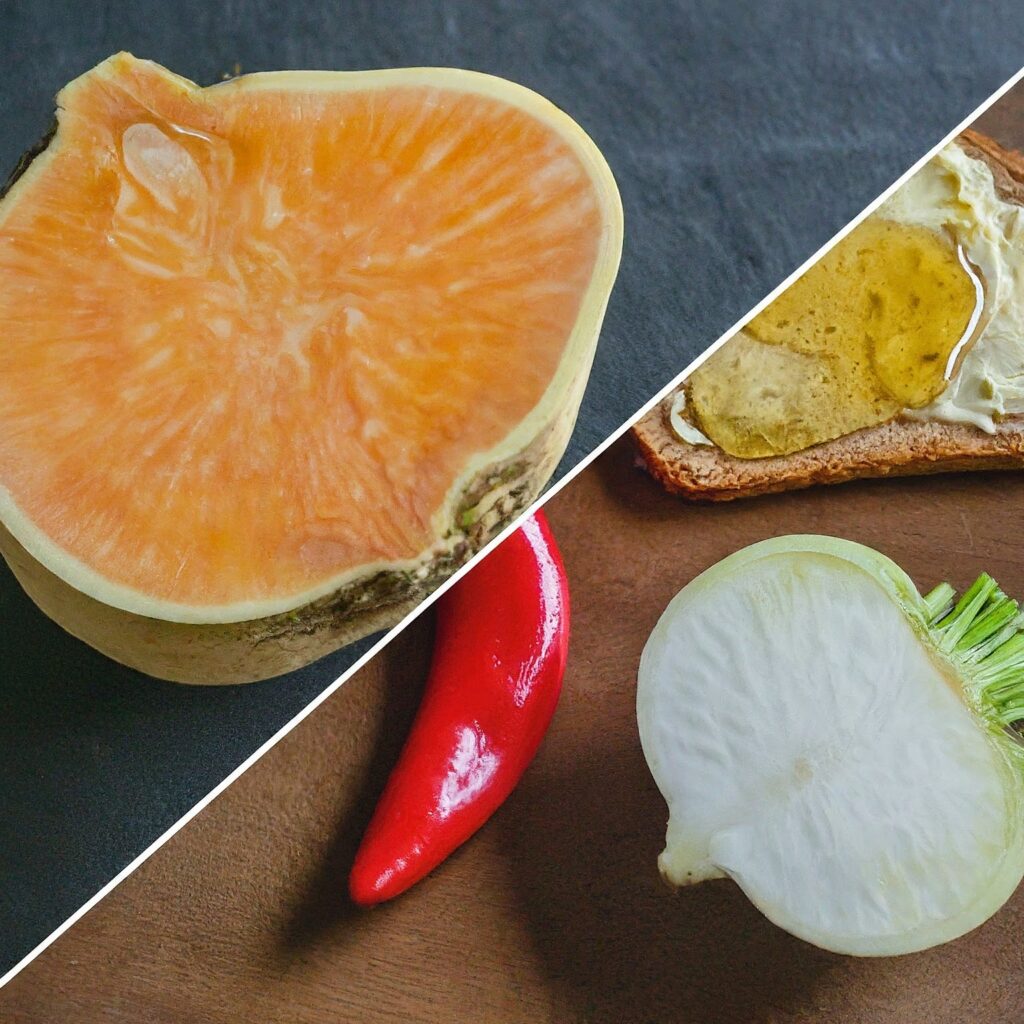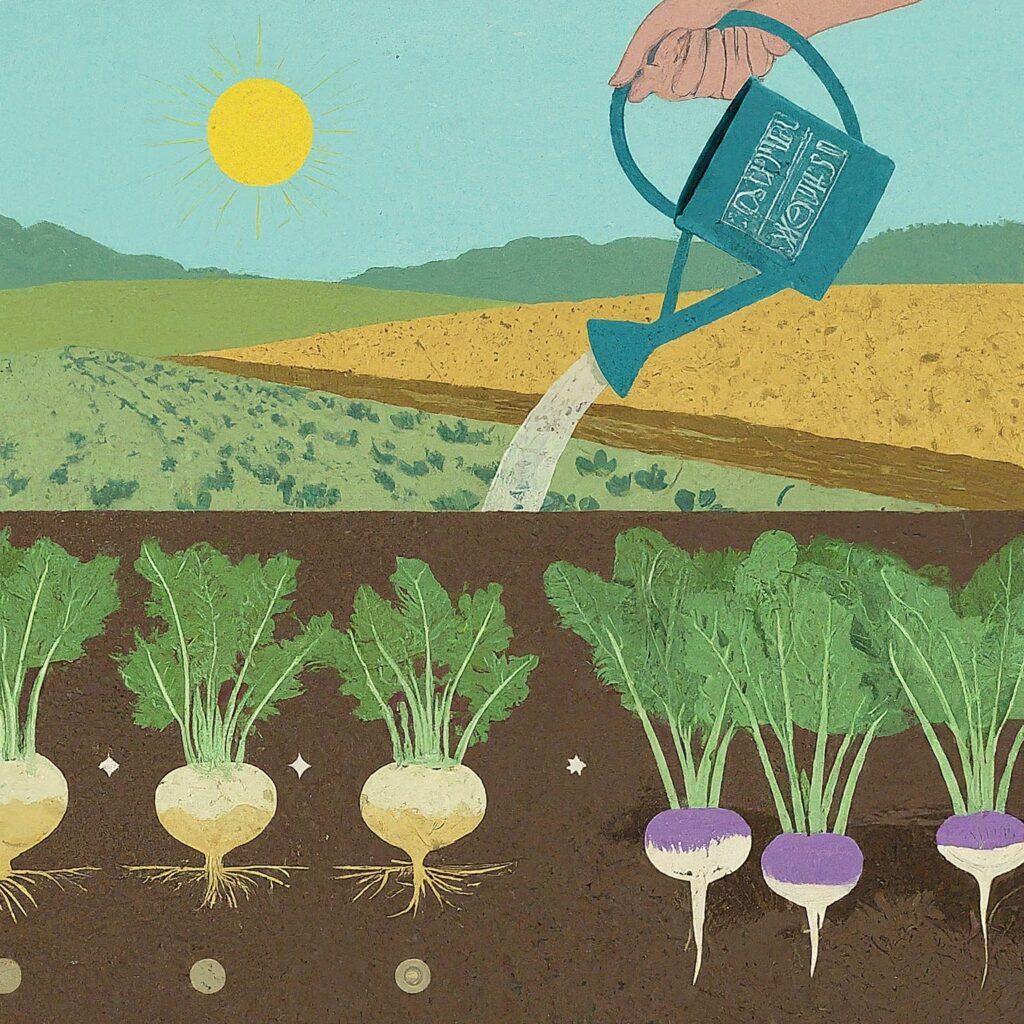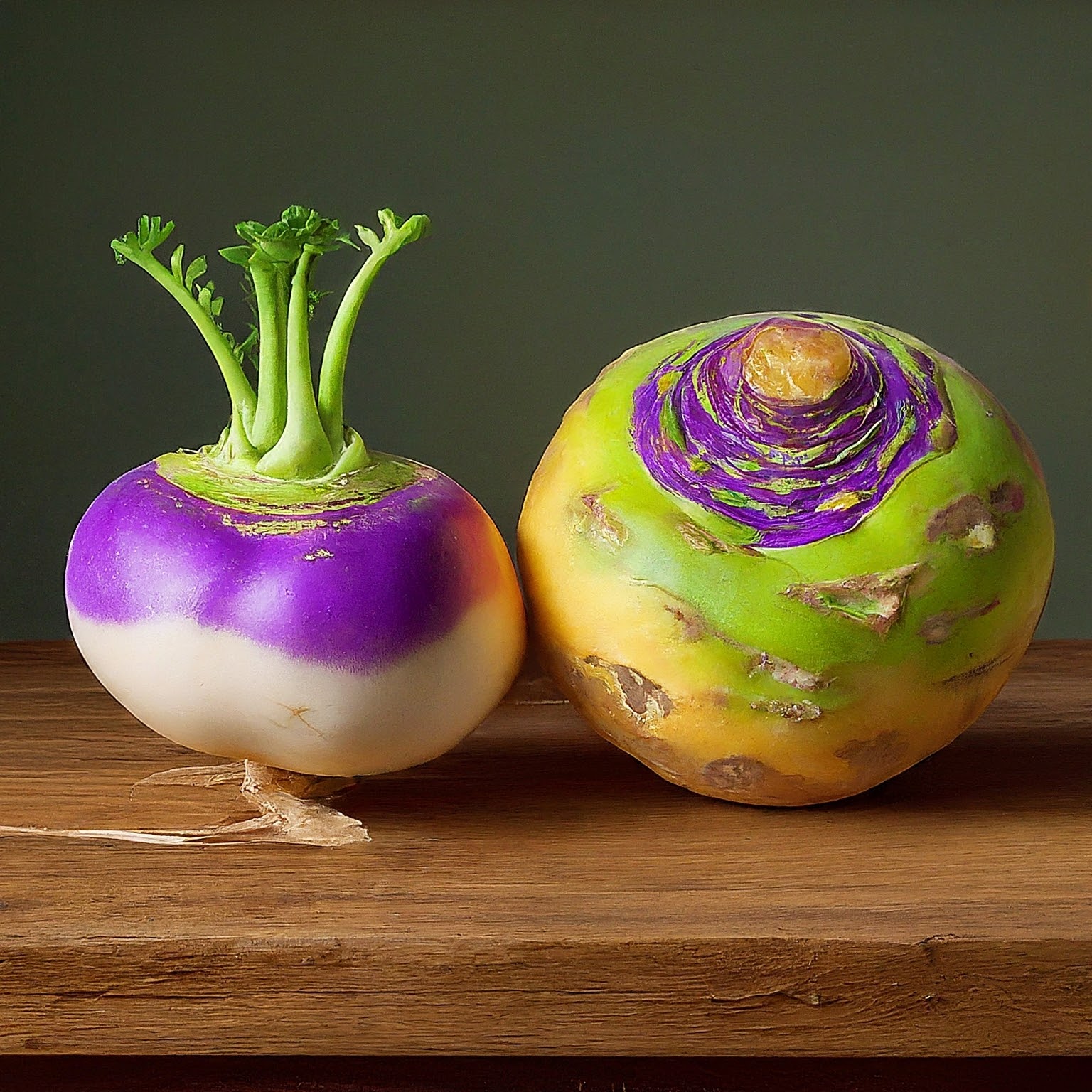Ever stared down a pile of root vegetables at the farmer’s market, unsure of the knobby brown orb whispering your name? You’re not alone! The world of root vegetables can be a confusing one, especially when it comes to the rutabaga vs turnip debate.
Turnip and rutabaga often get mistaken for each other since they look similar.
In this rutabaga vs turnip guide, we’ll go over the key differences between these root vegetables. We’ll also explore their culinary versatility, and unlock the secrets to growing and storing them like a pro.
Jump to a section:
Rutabaga vs Turnip: Key Differences

Rutabagas and turnips belong to the same family, Brassicaceae, alongside other veggie stars like kale and broccoli.
At first glance, these guys look like they could be very close cousins but don’t be fooled by their subterranean disguise because beneath the surface lie distinct personalities.
Let’s break down everything about these root vegetables to help you tell them apart:
Size
Imagine a baseball versus a softball. That’s the size difference between these rooty rivals!
The rutabaga is a heavyweight champion, having a hefty 5-8 inch diameter at maturity.
The turnip, on the other hand, is a more modest fellow, typically reaching a diameter of 2-4 inches.
So, next time you’re faced with a mystery root, remember: bigger is likely a rutabaga.
Skin
Looks can be deceiving, but in this case, they offer valuable clues.
The rutabaga sports a rough, bumpy exterior, often with a waxy yellowish-brown hue that can sometimes have a greenish tinge. Think of a rugged, knobby earth tone.
The turnip has a smoother, more delicate facade. Its skin can range from a classic white with a vibrant purple top to all-purple varieties, offering a more elegant contrast.
Flesh
Slice them open, and the differences become even clearer.
The rutabaga proudly features a vibrant yellow-to-orange interior, like a hidden sunset trapped underground.
The turnip, in contrast, has a snowy white flesh, pure and pristine.
Beyond the Basics
This isn’t just a battle of size, skin, and flesh color.
Here are some additional factors to consider:
- Flavor Profile: The rutabaga leans towards a sweeter, milder flavor with hints of cabbage. On the other hand, the turnip packs a slightly sharper punch, offering a peppery kick reminiscent of radishes, but milder.
- Maturity: The rutabaga takes longer to mature, typically needing 80-100 days from seed to harvest. The turnip is a speedier grower, ready in just 50-60 days.
- Cooking Time: Due to its larger size, the rutabaga might require a bit more cooking time compared to the turnip.
While both are delicious and nutritious, there’s no single winner in the rutabaga vs turnip battle. It all boils down to your personal preference.
Do you crave sweetness? Go for the rutabaga.
Looking for a bolder flavor? The turnip has you covered.
The beauty lies in their diversity, offering options to suit every palate and culinary adventure.
Here’s a handy table to settle the rutabaga vs turnip debate once and for all!
| Feature | Rutabaga | Turnip |
| Size | Heavyweight Champion (5-8 inches) | Modest Fellow (2-4 inches) |
| Skin | Rough, bumpy, waxy, yellowish-brown (sometimes greenish tinge) | Smooth, delicate, white with purple top (or all-purple) |
| Flesh | Vibrant yellow to orange | Snowy white |
| Flavor | Sweeter, milder, hints of cabbage | Peppery kick, reminiscent of radishes (but milder) |
| Maturity | Takes longer (80-100 days from seed) | Speedier grower (50-60 days from seed) |
| Cooking Time | May require a bit more time due to size | Generally cooks faster |
| Leaves | Bluish-green, more waxy bloom | Green, less waxy |
Rutabaga vs Turnip Uses

The beauty of rutabagas and turnips lies not just in their distinct personalities, but also in their remarkable culinary adaptability. These root vegetables are true culinary chameleons, transforming themselves into a variety of delicious dishes.
Whether you’re a seasoned chef or a kitchen novice, get ready to add some root vegetable magic to your meals!
Roasting
The best way to unleash the natural sweetness of these root vegetables is by roasting them!
Cut them into cubes, toss them with olive oil, your favorite herbs and spices (think rosemary, thyme, garlic powder), and roast until golden brown.
The result?
A heavenly side dish that pairs beautifully with roasted chicken, pork, or fish.
For the rutabaga, with its larger size, consider pre-cooking it for a few minutes to ensure even cooking throughout.
Mashing
Move over, potatoes!
You can transform both rutabagas and turnips into creamy and comforting mashes.
Simply boil or steam them until tender, then mash them with butter, milk, salt, and pepper.
Want to add a twist?
For a rutabaga mash, consider incorporating some grated Parmesan cheese or a splash of Dijon mustard.
For a turnip mash, experiment with chopped fresh herbs like chives or parsley. These flavorful mashes are a delightful addition to any weeknight dinner.
Soups and Stews
Looking to add depth and heartiness to your winter warmers? Look no further than rutabagas and turnips!
Dice up these root vegetables and let them simmer in your favorite soups and stews. They pair beautifully with beef, chicken, lentils, or even vegetarian broths.
The rutabaga adds a touch of sweetness, while the turnip brings a subtle peppery bite.
Experiment with different combinations to discover your perfect winter soup!
Salads
Who says you can’t enjoy root vegetables raw?
Both rutabagas and turnips can be grated finely and tossed into salads for a refreshing and healthy crunch.
The rutabaga adds a touch of sweetness that complements a variety of salad dressings, while the turnip offers a peppery kick that awakens the palate.
For an extra zing, consider pairing them with shredded carrots, crumbled goat cheese, and a honey-lemon vinaigrette.
Beyond the Basics
These are just a taste of the delicious dishes you can create with rutabagas and turnips.
Here are some additional ways to explore the versatility of rutabagas and turnips:
- Fries: Cut them into thin sticks and bake or air-fry for a healthier alternative to traditional french fries.
- Fritters: Grate them and combine them with eggs and flour for delicious and savory fritters.
- Noodles: Spiralize them for a unique and healthy low-carb noodle option.
- Pickles: For the adventurous foodies, try pickling them for a tangy and flavorful condiment.
While both offer a variety of culinary applications, there are some subtle differences to consider.
The rutabaga’s larger size might require slightly longer cooking times when roasting or mashing.
The turnip’s peppery flavor can be a bolder choice for salads or slaws, while the rutabaga might be a better fit for those who prefer a milder taste.
Ultimately, the best choice depends on your recipe and personal preferences.
So, experiment and have fun discovering the endless possibilities!
You may want to try this rutabaga recipe by Chef Buck:
Or check out this video that teaches how to cook turnip like a pro:
Rutabaga vs Turnip Taste

This is where the rutabaga vs turnip debate truly comes alive.
While both share a delicious earthiness characteristic of root vegetables, they each possess unique flavor profiles that will tantalize your taste buds in distinct ways.
The Rutabaga’s Taste
Imagine a world where sweetness meets earthiness in a harmonious dance.
The rutabaga boasts a flavor profile that is milder and sweeter than its turnip counterpart. Hints of cabbage peek through, adding a touch of complexity.
When cooked, this sweetness becomes even more pronounced, making it a delightful choice for those who prefer a touch of sugary satisfaction in their savory dishes.
Think of it as a gentler root vegetable, offering a comforting and familiar taste.
The Turnip’s Taste
The turnip packs a slightly sharper punch, offering a peppery kick reminiscent of its radish cousin.
However, this peppery bite is far more subdued, delivering a pleasant zing rather than an overpowering heat. This assertive flavor makes it a great choice for those who enjoy a bit more excitement on their palate.
Think of it as a zestier option, adding a lively and unexpected touch to your dishes.
So, which one reigns supreme in the taste department?
The answer, like most things in life, is subjective!
However, there are many factors that can influence the taste of both rutabagas and turnips.
Here are some things to consider:
- Freshness: Fresher vegetables will always have a more pronounced and pleasant flavor.
- Cooking Method: Roasting tends to bring out the sweetness of both vegetables while boiling can result in a milder taste.
- Seasoning: Don’t be afraid to experiment with herbs and spices! Garlic, rosemary, and thyme pair beautifully with both rutabagas and turnips, while a squeeze of lemon or a drizzle of honey can further enhance their unique flavors.
How to Grow Rutabaga and Turnip

These delicious and nutritious root vegetables are surprisingly easy to grow, rewarding you with a bountiful harvest come fall.
Planting
Both rutabagas and turnips thrive in cool-season weather.
Here’s the key to unlocking their growth potential:
- Timing: Sow your seeds directly outdoors 4-6 weeks before the last frost in your area. This ensures they have ample time to mature before the hot summer days arrive.
- Sun Exposure: For thriving rutabagas and turnips, find a well-lit spot! They need 6-8 hours of sunshine a day.
- Soil: Rutabagas and turnips prefer well-drained, fertile soil. Amending your soil with compost or aged manure before planting will provide them with the nutrients they need to thrive.
- Seeding: Sow your seeds about ½ inch deep and space them according to the following guidelines:
- Rutabagas: Keep 4-6 inches distance between seeds, knowing you’ll need to thin them later.
- Turnips: Space seeds 2-4 inches apart, again with thinning in mind.
Thinning
As seedlings emerge and develop their first few sets of true leaves, it’s time for thinning. This crucial step ensures proper spacing for healthy root development.
Here’s how to do it:
- Rutabaga: Once seedlings are about 4 inches tall, carefully thin them to 6-8 inches apart. You can gently pull out unwanted seedlings or use sharp scissors to snip them at the base.
- Turnip: When seedlings reach 2-3 inches tall, thin them to 4-6 inches apart. Follow the same methods as with rutabagas.
Watering
Consistent moisture is key for healthy root development of both turnip and rutabaga.
Water your rutabagas and turnips regularly, especially during germination and hot, dry spells.
Keep the soil evenly moist, but not soggy.
Weed Control
Weeds can steal valuable nutrients and moisture from your developing root vegetables.
Regularly weeding your garden bed will help ensure your rutabagas and turnips have the resources they need to thrive.
Pest Patrol
While not overly susceptible to pests, it is a good idea to keep an eye out for pesky cabbage moths and flea beetles.
Row covers can be a great way to deter these unwelcome visitors. You can use organic insecticidal soap sprays for pest control.
Learn more about DIY pest control.
Rutabaga vs Turnip Growth Timeline
Now for the exciting part – watching your harvest unfold!
- Rutabaga: These heavyweights take a bit longer to mature, typically needing 80-100 days from seed to harvest. Be patient, and you’ll be rewarded with delicious rutabagas that can reach 3-4 inches in diameter.
- Turnip: The speedier growers of the bunch, turnips are ready to harvest in just 50-60 days. Look for roots that reach 2-3 inches in diameter for optimal flavor and texture.
Harvesting
Time to harvest your delicious rutabagas and turnips!
Here’s how to know when your rutabagas and turnips are ready to be plucked from the ground:
- Size Matters: As mentioned above, harvest rutabagas when they reach 3-4 inches in diameter and turnips when they’re 2-3 inches in diameter.
- Feel the Force: Give them a gentle tug. If they resist easily, they’re likely not quite ready yet. If they come out of the ground easily, it’s harvest time!
Bonus Tip: For a continuous harvest of turnips, consider planting successive sowings every few weeks throughout the cool season.
With a little TLC and these handy tips, you’ll be well on your way to cultivating a bountiful harvest of rutabagas and turnips.
Now, get out there, plant those seeds, and enjoy the satisfaction of growing your own delicious and nutritious root vegetables!
How to Store Rutabaga and Turnip
Now that you’ve brought home your bounty, how do you store these root vegetables for maximum freshness?
- Storage: Both rutabagas and turnips thrive in cool, dark, and humid environments. The crisper drawer in your refrigerator is their happy place.
- Shelf life: When properly stored, expect your rutabagas to last for 2-3 months, while turnips will keep fresh for 1-2 months.
If you have a surplus harvest, consider freezing!
Simply chop them up, blanch them for a couple of minutes, and then freeze them in airtight containers. This way, you can enjoy their deliciousness all year round.
Rutabaga vs Turnip: Nutrition and Benefits
The world of root vegetables boasts hidden gems like rutabagas and turnips, offering a surprising nutritional punch alongside their delightful flavors.
These unassuming vegetables are packed with essential vitamins, minerals, and dietary fiber, making them valuable additions to any healthy diet.
So, let’s explore their unique benefits and the role they can play in your well-being.
Rutabaga: A Nutritional Powerhouse
Rutabagas are not just delicious, they’re powerhouses of essential nutrients!
Here’s a detailed breakdown of the vitamins and minerals they offer per 1 cup (cooked,
| Nutrient | Amount | Daily Value (DV) | Role in the Body |
| Calories | 52 | 2% | Provides energy for bodily functions |
| Carbohydrates | 12 g | 4% | Good energy source for the body and brain |
| Fiber | 3 g | 12% | Supports digestion, promotes gut health, and aids in feeling full |
| Vitamin C | 51 mg | 85% | Essential for immune function, collagen production, and antioxidant activity |
| Potassium | 337 mg | 10% | Regulates blood pressure, supports muscle function, and maintains fluid balance |
| Manganese | 0.8 mg | 16% | Crucial for enzyme function, metabolism, and antioxidant defenses |
| Vitamin B6 | 0.2 mg | 11% | Supports brain function, nervous system health, and red blood cell production |
Benefits of Including Rutabagas in Your Diet
- Strengthens Your Immune System: Jam-packed with vitamin C, a powerful antioxidant, rutabagas help fight off free radicals and keep your immune system functioning optimally.
- Boosts Gut Health: The high fiber content in rutabagas promotes healthy digestion and regularity. Fiber also helps you feel full for longer, aiding in weight management.
- Supports Heart Health: Potassium, abundant in rutabagas, plays a vital role in regulating blood pressure and reducing the risk of heart disease.
- Promotes Bone Health: Manganese, another key mineral found in rutabagas, contributes to bone health and metabolism.
- May Help Manage Blood Sugar: The fiber in rutabagas helps regulate blood sugar levels, making them a beneficial choice for those managing diabetes.
Turnip: A Champion of Essential Vitamins
Don’t underestimate the humble turnip when it comes to nutritional value!
This root vegetable packs a surprising nutritional punch, offering a valuable range of vitamins and minerals per 1 cup (cooked, diced) serving:
| Nutrient | Amount | Daily Value (DV) | Role in the Body |
| Calories | 37 | 1% | Provides energy for bodily functions |
| Carbohydrates | 9 g | 3% | Good energy source for the body and brain |
| Fiber | 2 g | 8% | Supports digestion, promotes gut health, and aids in feeling full |
| Vitamin C | 52 mg | 87% | Essential for immune function, collagen production, and antioxidant activity |
| Potassium | 205 mg | 6% | Regulates blood pressure, supports muscle function, and maintains fluid balance |
| Folate | 34 mcg | 9% | Crucial for cell growth, DNA synthesis, and fetal development |
| Manganese | 0.4 mg | 8% | Important for enzyme function, metabolism, and antioxidant defenses |
Benefits of Including Turnips in Your Diet
- Boosts Immunity: Just like rutabagas, turnips are excellent sources of vitamin C, which strengthens your body’s defense system against illness.
- Aids in Digestion: The dietary fiber in turnips promotes healthy gut function and regularity, keeping your digestive system working smoothly.
- May Support Heart Health: Potassium, found in considerable amounts in turnips, helps regulate blood pressure, a key factor in maintaining heart health.
- Promotes Cellular Health: Folate, present in turnips, plays a vital role in cell growth, DNA synthesis, and especially important during pregnancy for fetal development.
- May Aid in Weight Management: Fiber in turnips helps you feel full for longer, potentially contributing to weight management efforts.
The Rutabaga vs Turnip Nutritional Showdown: A Draw!
As you can see, both rutabagas and turnips offer a remarkable array of essential nutrients.
Here’s a closer look at how they compare:
| Nutrient | Rutabaga | Turnip | Winner |
| Calories | 52 | 37 | Turnip (Lower in calories) |
| Carbohydrates | 12 g | 9 g | Rutabaga (More energy source) |
| Fiber | 3 g | 2 g | Rutabaga (More for gut health) |
| Vitamin C | 51 mg | 52 mg | Tie (Both excellent sources) |
| Potassium | 337 mg | 205 mg | Rutabaga (More for blood pressure) |
| Manganese | 0.8 mg | 0.4 mg | Rutabaga (More for metabolism) |
| Vitamin B6 | 0.2 mg | N/A | Rutabaga (Supports brain function) |
| Folate | N/A | 34 mcg | Turnip (Important for cell growth) |
Rutabaga vs Turnip – More Than Just Root Rivals
With this guide, you can now confidently distinguish between rutabaga and turnip. They may be close cousins, but they each offer unique flavors and characteristics.
So, the next time you’re at the farmer’s market, don’t be afraid to experiment!
Whether you crave the sweetness of the rutabaga or the peppery kick of the turnip, both promise delicious and nutritious culinary adventures.
FAQ
Which is healthier, turnips or rutabagas?
As discussed earlier, it’s a close call!
Both of these root vegetables have a similar range of vitamins and minerals. Choose whichever one you enjoy more, or better yet, incorporate both into your diet for a well-rounded nutritional boost.
Why is rutabaga called turnip?
The confusion is understandable since they look similar!
Rutabaga is a delicious hybrid born from the union of a turnip and a cabbage. The name “rutabaga” comes from the Swedish word “rotebaga,” which translates to “turnip-like root.”
Can you substitute rutabaga for turnips?
Absolutely! They’re quite interchangeable in recipes.
Just keep in mind that rutabagas might take a bit longer to cook due to their larger size. You may need to adjust the cooking time slightly depending on the recipe.
Can rutabaga be eaten raw?
Yes, you can! Rutabaga has a slightly milder flavor than turnips when raw. Grate it finely for a salad or slaw, or cut it into matchsticks for a crunchy snack with a dip.
Can turnip be eaten raw?
Similar to rutabaga, you can enjoy turnips raw. Their flavor is a bit more peppery, so keep that in mind when incorporating them into your dishes. Try thinly sliced turnips on sandwiches for a surprising burst of flavor and texture.



